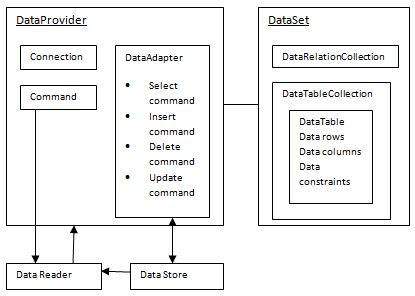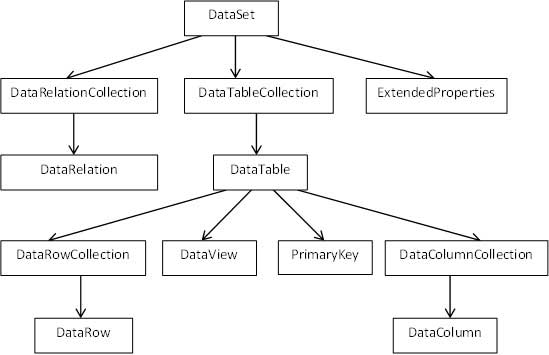ADO.NET provides consistent access to data sources such as Microsoft SQL Server, as well as data sources exposed through OLE DB and XML. Data-sharing consumer applications can use ADO.NET to connect to these data sources and retrieve, manipulate, and update data.
ADO.Net Object Model
ADO.Net object model is nothing but the structured process flow through various components. The object model can be pictorially described as:

The data residing in a data store or database is retrieved through the data provider. Various components of the data provider retrieve data for the application and update data.
An application accesses data either through a dataset or a data reader.
- Datasets store data in a disconnected cache and the application retrieves data from it.
- Data readers provide data to the application in a read-only and forward-only mode.
Data Provider
A data provider is used for connecting to a database, executing commands and retrieving data, storing it in a dataset, reading the retrieved data and updating the database.
The data provider in ADO.Net consists of the following four objects:
| S.N | Objects & Description |
|---|---|
| 1 | Connection This component is used to set up a connection with a data source. |
| 2 | Command A command is a SQL statement or a stored procedure used to retrieve, insert, delete or modify data in a data source. |
| 3 | DataReader Data reader is used to retrieve data from a data source in a read-only and forward-only mode. |
| 4 | DataAdapter This is integral to the working of ADO.Net since data is transferred to and from a database through a data adapter. It retrieves data from a database into a dataset and updates the database. When changes are made to the dataset, the changes in the database are actually done by the data adapter. |
There are following different types of data providers included in ADO.Net
- The .Net Framework data provider for SQL Server - provides access to Microsoft SQL Server.
- The .Net Framework data provider for OLE DB - provides access to data sources exposed by using OLE DB.
- The .Net Framework data provider for ODBC - provides access to data sources exposed by ODBC.
- The .Net Framework data provider for Oracle - provides access to Oracle data source.
- The EntityClient provider - enables accessing data through Entity Data Model (EDM) applications.
DataSet
DataSet is an in-memory representation of data. It is a disconnected, cached set of records that are retrieved from a database. When a connection is established with the database, the data adapter creates a dataset and stores data in it. After the data is retrieved and stored in a dataset, the connection with the database is closed. This is called the 'disconnected architecture'. The dataset works as a virtual database containing tables, rows, and columns.
The following diagram shows the dataset object model:

The DataSet class is present in the System.Data namespace. The following table describes all the components of DataSet:
| S.N | Components & Description |
|---|---|
| 1 | DataTableCollection It contains all the tables retrieved from the data source. |
| 2 | DataRelationCollection It contains relationships and the links between tables in a data set. |
| 3 | ExtendedProperties It contains additional information, like the SQL statement for retrieving data, time of retrieval, etc. |
| 4 | DataTable It represents a table in the DataTableCollection of a dataset. It consists of the DataRow and DataColumn objects. The DataTable objects are case-sensitive. |
| 5 | DataRelation It represents a relationship in the DataRelationshipCollection of the dataset. It is used to relate two DataTable objects to each other through the DataColumn objects. |
| 6 | DataRowCollection It contains all the rows in a DataTable. |
| 7 | DataView It represents a fixed customized view of a DataTable for sorting, filtering, searching, editing and navigation. |
| 8 | PrimaryKey It represents the column that uniquely identifies a row in a DataTable. |
| 9 | DataRow It represents a row in the DataTable. The DataRow object and its properties and methods are used to retrieve, evaluate, insert, delete, and update values in the DataTable. The NewRow method is used to create a new row and the Add method adds a row to the table. |
| 10 | DataColumnCollection It represents all the columns in a DataTable. |
| 11 | DataColumn It consists of the number of columns that comprise a DataTable. |
No comments:
Post a Comment